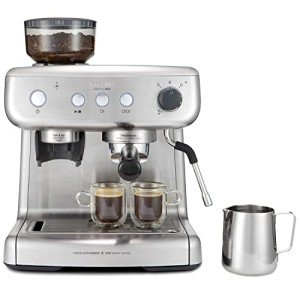Heat Exchange Espresso Machines: A Comprehensive Guide
Espresso machines have actually progressed substantially throughout the years, accommodating the needs of home baristas and coffee professionals alike. Among these machines, heat exchange espresso machines have gotten popularity due to their capability to deliver consistent efficiency and exceptional brew quality. In Espresso Maker Online , we will explore the functions, benefits, and essential features of heat exchange espresso machines, providing a thorough understanding for both potential buyers and coffee lovers.
Comprehending Heat Exchange Technology
Heat exchange espresso machines operate on an unique concept that enables simultaneous water heating for developing and steaming. They are equipped with a single boiler that uses a heat exchanger system. This function is substantial as it makes it possible for users to brew espresso while steaming milk concurrently, promoting efficiency in the coffee-making process.
How Does a Heat Exchange Espresso Machine Work?
The procedure begins with the machine's water inlet filling the boiler. As the water warms up, it turns to steam. The ingenious heat exchanger uses hot steam to heat additional water in a different passage designed specifically for the brew group. This implies that water can reach the ideal brewing temperature without waiting for the boiler to change. The essential steps include:
- Water Fill: Water is drawn into the boiler.
- Heating Process: The boiler warms up as water is converted into steam.
- Heat Exchange: Steam heats up water in the heat exchanger tube.
- Brewing: Water from the heat exchanger is pushed through coffee grounds, extracting the flavors needed for an abundant espresso.
This procedure enables fast temperature level changes and improved coffee extraction.
Benefits of Heat Exchange Espresso Machines
Heat exchange espresso machines use a number of advantages, particularly for those wanting to maximize their coffee experience. Here are some essential advantages:
- Simultaneous Brewing and Steaming: Users can brew espresso while steaming milk, making it perfect for hectic coffee shops and home baristas who value efficiency.
- Temperature level Stability: The boiler's steam pressure assists preserve a steady temperature, which is critical for constant espresso extraction.
- Flexibility: The design enables fast switching in between developing and steaming, making it simpler to develop different coffee beverages, from lattes to cappuccinos.
- User-friendly: Models frequently include available controls, making it possible for both beginners and experienced baristas to produce quality drinks.
- Professional Quality: Heat exchange machines are often used in commercial settings, offering users with high-quality brewing performance in your home.
Secret Features to Look for in Heat Exchange Espresso Machines
When considering the purchase of a heat exchange espresso machine, there are several functions that one ought to take into consideration:
- Build Quality: Look for machines made from long lasting products, such as stainless-steel or brass, ensuring longevity.
- Boiler Size: A larger boiler will hold more water and sustain higher output in time.
- PID Temperature Control: This function assists keep constant brew temperatures, which can boost the coffee-making procedure.
- Group Head Design: Machines with a saturated or semi-saturated group head provide much better temperature stability.
- Ease of Use: User-friendly user interfaces and user-friendly controls improve the overall experience for baristas at all skill levels.
- Steam Wand Quality: A good steam wand with appropriate insulation and versatility enables better texturing of milk.
- Water Reservoir Size: Depending on your requirements, consider how frequently you wish to refill the water reservoir.
Contrast of Popular Heat Exchange Espresso Machines
To much better comprehend the alternatives available in the market, listed below is a comparison table of some popular heat exchange espresso machines:
| Machine Model | Boiler Size | PID Control | Rate Range | User Ratings |
|---|---|---|---|---|
| Profitec Pro 700 | 2.0 L | Yes | ₤ 2,000-₤ 2,500 | 9.5/ 10 |
| Rocket Espresso R58 | 1.8 L | Yes | ₤ 2,400-₤ 2,800 | 9.4/ 10 |
| Elekta Bianca | 1.8 L | Yes | ₤ 2,500-₤ 3,000 | 9.6/ 10 |
| La Spaziale S1 Vivaldi II | 1.5 L | Yes | ₤ 1,800-₤ 2,200 | 9.2/ 10 |
| Bezzera Magica | 1.2 L | No | ₤ 1,600-₤ 1,800 | 9.0/ 10 |
Frequently Asked Questions About Heat Exchange Espresso Machines
What is the primary difference in between a heat exchange and a dual boiler espresso machine?
While both types can brew espresso and steam milk at the same time, dual boiler machines have separate boilers for developing and steaming. In contrast, heat exchange machines utilize a single boiler and a heat exchanger to achieve the very same function.
Are heat exchange machines ideal for newbies?
Yes! Lots of heat exchange machines are developed with easy to use features, making them accessible for novices. With appropriate guidance and practice, users can rapidly produce quality espresso.
What kind of upkeep do heat exchange espresso machines need?
Regular upkeep includes descaling, cleaning the boiler, checking seals and gaskets, and keeping the group head tidy. Regular upkeep guarantees longevity and constant performance.
Can I use a heat exchange machine for various types of coffee beverages?
Absolutely! Heat exchange machines allow users to create a range of coffee drinks, including espresso, lattes, coffees, and more.
Heat exchange espresso machines represent a mix of innovation and tradition, providing coffee enthusiasts with the tools needed for crafting the best cup. Their capability to at the same time brew and steam, combined with accurate temperature control, makes them a compelling option for both home baristas and specialists. With the right understanding on features and maintenance, users can open a world of charming coffee experiences, ensuring that each sip is as delightful as the last.

